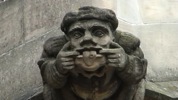…or a spiritual telescope directed inwards.
Shakespeare was born in the same year as Galileo. He was to literature what the latter was to science. Yet one belonged to the traditions of the past and the other the future. The pre-scientific age was in its final stages. How important this is when studying Shakespeare!
Shakespeare was the last of the humoral psychologists, climbing a spiritual ladder whilst holding onto the great chain of being. These concepts (the humours, ladder or chain of being) existed since the Greeks and the Romans, but they were about to die in the light of science and a new reasoning.
Today’s blog reflects my latest read, ‘Renaissance Magic and Hermeticism in the Shakespeare Sonnets: like Prayers Divine’ by Thomas O Jones. Edward Mellen Press. 1995.
This area of Renaissance magic has been explored by Frances Yates in her seminal book ‘Giordano Bruno and the Hermetic Tradition’ printed in 1964. 500 years after Ficino finished translating Corpus Hermeticum and 400 after the births of Shakespeare and Galileo.
Scholars seem to neglect old Frances as a bit kooky. She opens up a whole set of questions that don’t fit into modern theories of literature or science. Shakespeare and all his Early Modern Renaissance contemporaries would have understood implicitly.
And that in the end is what can bring us the closest to his original intent in writing in the first place. He was subject to the forms and pressures of his times but what exactly were they?
The more we uncover as researchers of the Early Modern period, the more we discover about how people lived and read what was written by their contemporaries. Because how they read was different and yet similar.
I guess I’m saying I have a basic anthropological need to know what drove a man like Shakespeare. it’s way beyond poetry now.
‘o that record could with a backward look…
show me your image in some antique book.’

Leave a Reply
You must be logged in to post a comment.